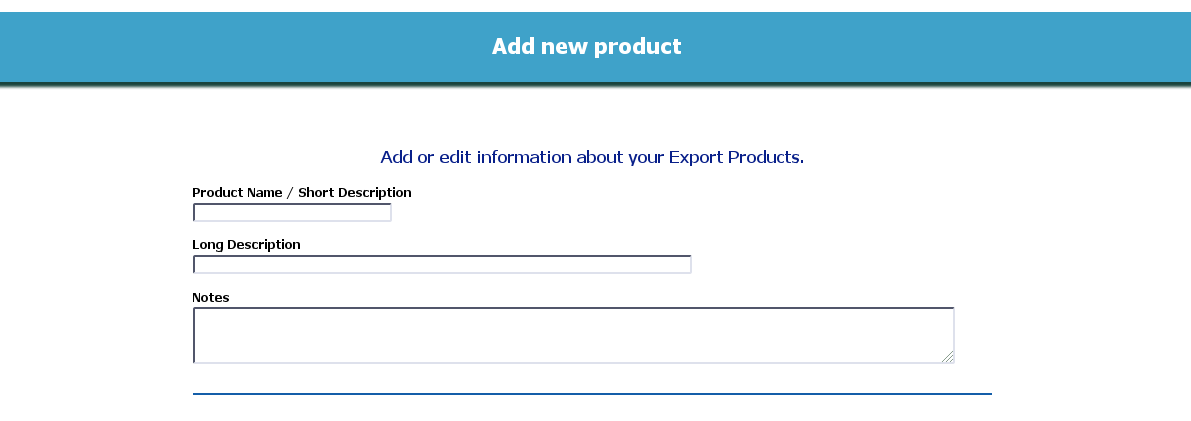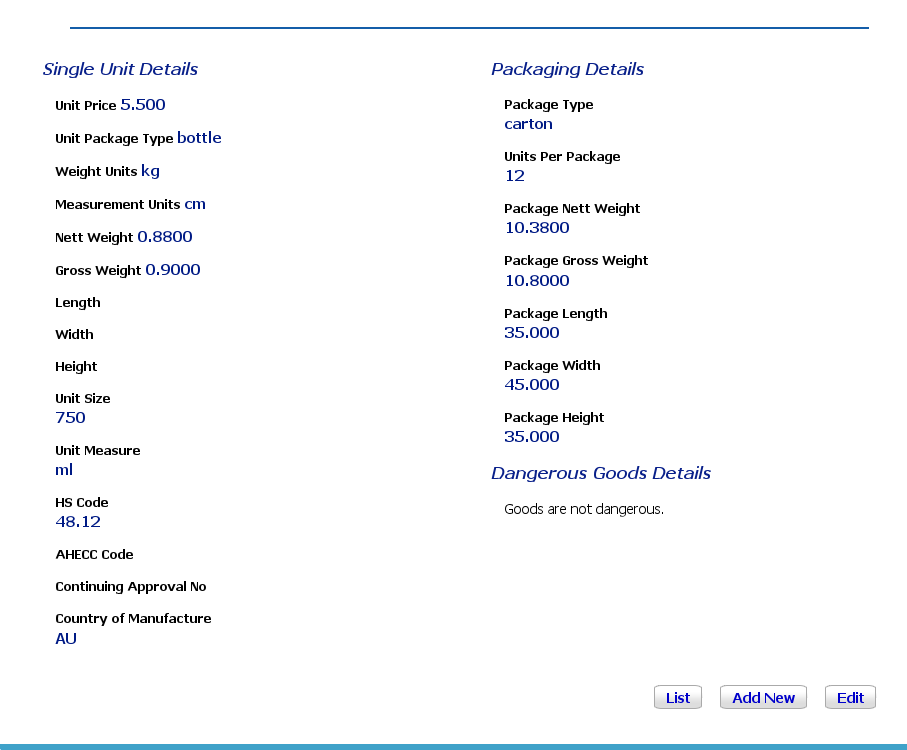
The Add New Product screen - name, description and notes
Go to the Main Menu and click Add a new Product from the links on that screen - you will be taken to the Add New Product screen.

The Add New Product screen - name, description and notes
The top part of the Add New Product screen contains fields for base product information:
the short description - this can be a name or code, and will be used for searching for the product. Short description has a maximum length of 60 characters.
the long description - this will be used on Export Documents. Long description has a maximum length of 100 characters.
notes about the product - these notes are for your use, and will not appear on any Export Documents. You will see the count of remaining available characters below the Notes field.
On the bottom half of the screen, you enter the details about packaging, weights, dimensions and prices.

Product details - Unit and Multiple
Product details are divided into two columns: Unit Details and Multiple Unit Packaging details. For instance, a Unit might be a bottle, a packet or a carton; multiples might be a case, a carton or a pallet, respectively. You will most likely need Unit information for your Export Invoice, and Multiple information for Packing Lists; this will depend on the particular shipment.
This field accepts numbers only (no currency symbol), and can take up to 9 digits before a decimal place. If you have a very large number, do not add zero cents - ITDocs will take care of that for you when it is time to produce the documents.
These units refer only to this product; you can have some products with kg/cm and some with lb/in. All measurements and weights are converted to kg/cm when the documents are produced.
You can even have a mixture of metric and imperial measures in a single product - ITDocs will do the necessary calculations when the product is used in a shipment.
This field is used to describe the package type, such as bottle, can, piece, and so forth. It can also be weight units, for instance tonnes of grain. As a rule of thumb, the unit type is the package or quantity for which you have a price, and which will appear on the Export Invoice.
The length, width and height of the unit. Make sure you use the measurement units you have selected earlier.
These dimensions are not necessary unless the packing list will use the unit dimensions, so they are not mandatory fields.
These fields are useful if, for instance, the product is wine in bottles, where you will enter 750 in Unit Size and ml in Unit Measure; thus it is possible to have a 750ml bottle of wine as a unit.
These fields must be completed - your product will not be saved unless they are.
The AHECC code is the Australian Harmonised Export Customs Code, and will be required for exports out of Australia.
The HS Code is the international Harmonised System Code, and will be required at destination.
The HS Code is generally the same as the first 4 digits of the AHECC code. For some applications such as Free Trade Agreement Certificates of Origin, 6 digits are required.
This field is not mandatory, but should be completed if your product has a CAN.
This field is mandatory.
Choose the appropriate country from the drop-down list; even if you are shipping from Australia, if the product is manufactured overseas, you should choose the country where it is manufactured.
The data you will enter in these fields are needed for packing lists where you package items for shipment in cartons, pallets, crates or other aggregates for shipment.
Do not include shipping containers in this item.
Enter carton, pallet, crate, or whatever the multiple package is.
Enter the number of units in the multiple package - enter a number only, since the type of unit is already in the Unit details.
As with the unit weights and dimensions, remember to use the dimensions that match the measurement units you have chosen for units.
If this product does not classify as a Dangerous Good, select No; the other fields will then disappear.
If it does classify as a Dangerous Good, select Yes. Completing the remaining fields, or selecting the proper information on the dropdowns, is mandatory if this is a Dangerous Good.
When you are entering data into these fields, you can use cut, copy and paste as with all data entry fields.
When you have completed adding data, you have three buttons at the bottom of the data entry screen to choose from:
Save and Review - this will save your data and open the product review screen with the data displayed, so you can check that it is correct. Click on the Edit button to return to the data entry screen, or click on Add New to add a new Product. Click on List to return to the Product List screen.
Save and New - Save the data for this product and open a new, empty data screen to add a new product.
Clear Form - remove all the data from the fields so you can start again.